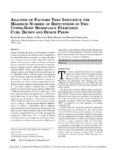Mostrar o rexistro simple do ítem
Analysis of factors that influence the maximum number of repetitions in two upper-body resistance exercises: curl biceps and bench press
| dc.contributor.author | Carballeira, Eduardo | |
| dc.contributor.author | Iglesias-Soler, Eliseo | |
| dc.contributor.author | Boullosa, Daniel | |
| dc.contributor.author | Dopico-Calvo, Xurxo | |
| dc.date.accessioned | 2024-05-03T14:30:34Z | |
| dc.date.issued | 2010-06 | |
| dc.identifier.citation | Iglesias, E., Boullosa, D. A., Dopico, X., & Carballeira, E. (2010). Analysis of factors that influence the maximum number of repetitions in two upper-body resistance exercises: curl biceps and bench press. Journal of strength and conditioning research, 24(6), 1566–1572. https://doi.org/10.1519/JSC.0b013e3181d8eabe | es_ES |
| dc.identifier.issn | 1064-8011 | |
| dc.identifier.uri | http://hdl.handle.net/2183/36403 | |
| dc.description.abstract | [Abstract]: Iglesias, E, Boullosa, DA, Dopico, X, and Carballeira, E. Análisis of factors that influence the maximum number of repetitions in two upper-body resistance exercises: curl biceps and bench press. J Strength Cond Res 24(6): 1566–1572, 2010—The purpose of this study was to analyze the influence of exercise type, set configuration, and relative intensity load on relationship between 1 repetition maximum (1RM) and maximum number of repetitions (MNR). Thirteen male subjects, experienced in resistance training, were tested in bench press and biceps curl for 1RM, MNR at 90% of 1RM with cluster set configuration (rest of 30s between repetitions) and MNR at 70% of 1RM with traditional set configuration (no rest between repetitions). A lineal encoder was used for measuring displacement of load. Analysis of variance analysis revealed a significant effect of load (p , 0.01) and a tendency in exercise factor (p = 0.096), whereas the interaction effect was not significant. MNR at 70% of 1RM was lower for biceps curl (16.31 6 2.59 vs. 8.77 6 3 in bench press and biceps curl, respectively; p , 0.05) and at 90% of 1RM (21.85 611.06 vs. 18.54 612.84 in bench press and biceps curl, respectively; p . 0.05). Correlation between 1RM and MNR was significant for medium-intensity in biceps curl (r = 20.574; p , 0.05) and between MNR and 1RM/body mass (r = 20.574; p , 0.05). Neither 1RM nor 1RM/body mass correlated with velocity along set, so velocity seems to be similar at a same relative intensity for subjects with differences in maximum strength levels. From our results, we suggest the employment of MNR rather than % of 1RM for training monitoring. Furthermore, we suggest the introduction of cluster set configuration for upper-body assessment of MNR and for upper-body muscular endurance training at high-intensity loads, as it seems an efficient approach in looking for sessions with greater training volumes. This could be an interesting approach for such sports as wrestling or weightlifting. | es_ES |
| dc.language.iso | eng | es_ES |
| dc.publisher | National Strength and Conditioning Association | es_ES |
| dc.relation.uri | https://doi.org/10.1519/JSC.0b013e3181d8eabe | es_ES |
| dc.rights | Copyright © Lippincott Williams & Wilkins | es_ES |
| dc.subject | Set configuration | es_ES |
| dc.subject | Resistance training | es_ES |
| dc.subject | Bench press | es_ES |
| dc.subject | Biceps curl | es_ES |
| dc.title | Analysis of factors that influence the maximum number of repetitions in two upper-body resistance exercises: curl biceps and bench press | es_ES |
| dc.type | info:eu-repo/semantics/article | es_ES |
| dc.rights.access | info:eu-repo/semantics/embargoedAccess | es_ES |
| dc.date.embargoEndDate | 9999/99/99 | es_ES |
| dc.date.embargoLift | 9999 | |
| UDC.journalTitle | Journal of Strength and Conditioning Research | es_ES |
| UDC.volume | 24 | es_ES |
| UDC.issue | 6 | es_ES |
| UDC.startPage | 1566 | es_ES |
| UDC.endPage | 1572 | es_ES |
| dc.identifier.doi | https://doi.org/10.1519/JSC.0b013e3181d8eabe |
Ficheiros no ítem
Este ítem aparece na(s) seguinte(s) colección(s)
-
GI-PHG - Artigos [112]






